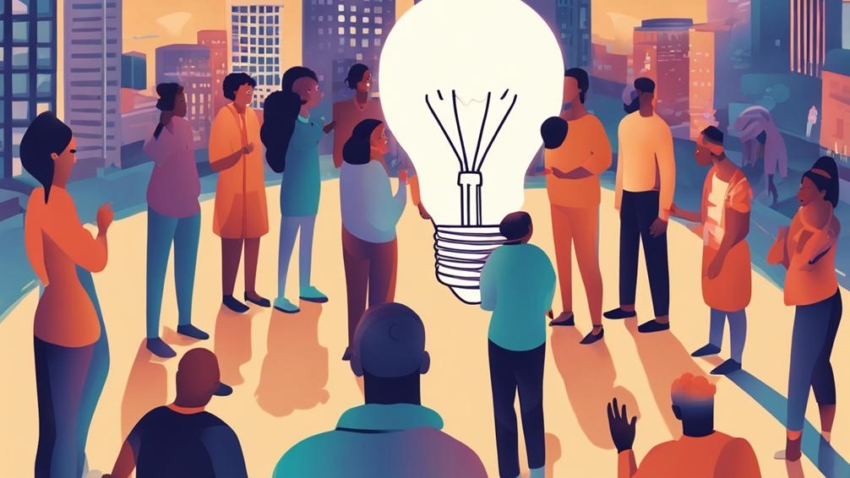
Driving Change: How Financial Literacy Can Transform Communities
You're likely living in a community where financial illiteracy is crippling economic growth, trapping people in debt, and hindering progress. The stats are staggering – 65% of Americans can't access a basic financial literacy test, and 40% lack savings to cover a $400 emergency. But there's hope. By empowering communities through education, you can break the cycle of poverty and create wealth. You can create a culture of savings, invest in local businesses, and stimulate economic growth. As you explore the connection between financial literacy and community transformation, you'll discover the key to accessing a brighter financial future for yourself and those around you.
Financial Illiteracy by the Numbers
Roughly 65% of Americans can't pass a basic financial literacy test, and you might be one of them. This staggering statistic highlights a critical issue plaguing our society – financial illiteracy. You might be surprised to know that even those with higher incomes and education levels struggle with basic financial concepts.
You're not alone if you're unsure about how to manage debt, invest wisely, or create a budget that actually works. The consequences of financial illiteracy are far-reaching, from missed opportunities to crippling debt. It's time to take control of your financial future and start making informed decisions.
The numbers don't lie – Americans are struggling to make ends meet. You might be part of the 40% who don't have enough savings to cover a $400 emergency or the 20% who are struggling to pay their bills on time. The truth is, financial literacy is not just a personal problem, but a societal issue that affects us all.
You have the power to change your financial trajectory. By taking the first step towards financial literacy, you're not only improving your own life, but also contributing to a more financially savvy community. It's time to break free from financial uncertainty and take control of your future.
Breaking the Cycle of Poverty
As you explore the complexities of poverty, you'll realize that it's a multifaceted issue that can be incredibly difficult to escape. You'll encounter situations where poverty traps exist, limiting opportunities and making it hard to break free. You'll also see how limited access to resources and cycles of debt can perpetuate poverty, making it a seemingly inescapable reality.
Poverty Traps Exist
You may think you're making progress, but poverty traps can keep you stuck in a cycle of debt and financial insecurity, making it difficult to escape. These traps can manifest in various ways, such as high-interest rates, payday lending, and predatory financial practices. They can also be perpetuated by limited access to education, job opportunities, and social services.
| Poverty Trap | Characteristics | Consequences |
|---|---|---|
| Debt Cycle | High-interest rates, fees, and penalties | Perpetual debt, financial strain |
| Limited Education | Lack of financial literacy, job skills | Reduced earning potential, limited opportunities |
| Predatory Practices | Unfair lending terms, hidden fees | Exploitation, financial insecurity |
To break free from these traps, it's essential to recognize their existence and understand how they operate. By acknowledging the obstacles, you can begin to develop strategies to overcome them. This might involve seeking out alternative financial services, building an emergency fund, or investing in education and job training. By taking proactive steps, you can start to break the cycle of poverty and create a more stable financial future.
Limited Access Hinders
One major obstacle to breaking the cycle of poverty is limited access to essential resources, including affordable financial services, quality education, and job opportunities that can help you build a more stable financial future. Without these resources, you're often forced to rely on predatory services that charge exorbitant fees, perpetuating the cycle of poverty. You might not have access to affordable banking services, making it difficult to save money or access credit. Quality education, which could provide you with better job opportunities, may be out of reach due to financial constraints or lack of access. This limited access hinders your ability to gain the financial literacy and skills necessary to make informed decisions about your financial life.
As a result, you may feel trapped, with limited options for improving your financial situation. You're not alone; millions of people face similar challenges. However, by acknowledging this obstacle, you can begin to seek out alternative solutions, such as community-based financial services or online education platforms. By doing so, you can start to break down the barriers that stand between you and a more stable financial future.
Cycles of Debt
Debt cycles, fueled by high-interest rates and fees, can ensnare you in a vicious loop, making it increasingly difficult to escape the cycle of poverty. You might find yourself trapped in a never-ending cycle of borrowing, debt, and repayment, with no clear way out.
| Debt Type | Interest Rate | Fees |
|---|---|---|
| Payday Loans | 390% | $15 per $100 borrowed |
| Credit Cards | 25% | Late fees up to $35 |
| Title Loans | 300% | Repo fees up to $500 |
| Bank Overdrafts | 36% | NSF fees up to $35 |
These debt types can quickly add up, making it hard for you to break free. The high-interest rates and fees can lead to a debt spiral, where you're paying more in interest and fees than the initial loan amount. It's essential to recognize the dangers of these debt cycles and take proactive steps to avoid them. By understanding the terms and conditions of your loans and credit agreements, you can make informed decisions and avoid falling into the debt trap.
Empowering Communities Through Education
As you work to empower your community through education, you're taking the first steps towards building a strong financial foundation. By focusing on financial literacy, you'll be creating a ripple effect that ultimately leads to community wealth creation. By investing in your community's financial knowledge, you're paving the way for a brighter, more prosperous future.
Building Financial Foundations
By grasping essential money management skills, you'll be empowered to break the cycle of financial uncertainty and build a stronger economic future for yourself and your community. It's time to shift your mindset and take control of your financial well-being. Building financial foundations is about creating a solid base for long-term economic stability.
Here's a snapshot of what that looks like:
| Financial Foundations | Benefits |
|---|---|
| Setting financial goals | Clarity on what you want to achieve |
| Creating a budget | Control over your income and expenses |
| Managing debt | Freedom from financial burdens |
| Building an emergency fund | Peace of mind in uncertain times |
Community Wealth Creation
Through targeted financial education, you can empower your community to break down economic barriers and build collective wealth. By providing access to financial knowledge, you can equip community members with the skills to manage their finances effectively, make informed decisions, and create a stable financial foundation. This, in turn, can lead to increased economic mobility, reduced poverty rates, and improved overall well-being.
As you educate your community, you'll notice a shift in mindset – from financial stress to financial confidence. Community members will begin to see the value in saving, investing, and entrepreneurship, leading to increased economic activity and growth. Additionally, as financial literacy spreads, you'll witness the emergence of community-driven initiatives, such as cooperative banks, credit unions, and social enterprises. These initiatives will not only create jobs but also foster a sense of community ownership and social responsibility. By empowering your community through financial education, you'll tap into the potential for collective wealth creation, paving the way for a brighter, more prosperous future.
Financial Literacy in Public Schools
You likely remember learning about fractions, algebra, and geometry in public school, but do you recall ever taking a class specifically on personal finance or money management? Probably not. This oversight is remarkable, considering how vital financial literacy is to navigating adulthood. The lack of financial education in public schools has contributed to a society where many struggle with debt, credit, and savings.
Integrating financial literacy into public school curricula can have a profound impact on students' futures. By teaching essential skills like budgeting, saving, and investing, we can empower students to make informed decisions about their financial lives. This, in turn, can lead to better credit scores, lower debt, and a more stable financial future.
Moreover, teaching financial literacy in public schools can help bridge the wealth gap. Low-income students, in particular, can benefit from learning how to manage their finances effectively, breaking the cycle of poverty and debt that often plagues their communities.
Economic Growth Through Informed Decisions
When you make informed financial decisions, you're not only securing your own financial future, but also contributing to the economic growth of your community. By understanding how to manage your finances effectively, you're more likely to invest in local businesses, pay taxes, and create jobs. This, in turn, stimulates economic growth and development in your community.
But that's not all. When you make informed financial decisions, you're also more likely to:
- Start a business: With a solid understanding of financial concepts, you'll be better equipped to launch a successful business venture, creating jobs and opportunities for others in your community.
- Invest in your community: By making smart financial decisions, you'll have more disposable income to invest in local initiatives, charities, and community projects.
- Break the cycle of poverty: By teaching others about financial literacy, you can help break the cycle of poverty and create a more financially stable community.
Creating a Culture of Savings
Financial independence begins with a mindset shift, as individuals prioritize saving and investing in their future, fostering a culture that values long-term security over instant gratification. You're not just building a safety net; you're creating a foundation for long-term prosperity. By adopting a savings-oriented mindset, you'll develop a sense of financial discipline that will serve you well in the years to come.
When you prioritize saving, you're more likely to make conscious spending decisions, avoiding debt and unnecessary expenses. You'll also become more aware of your financial habits, identifying areas where you can cut back and allocate resources more efficiently. As you build your savings, you'll experience a sense of security and confidence that comes with knowing you're prepared for the unexpected.
Creating a culture of savings also has a ripple effect on your community. When individuals prioritize saving, they're more likely to invest in their local economy, supporting local businesses and stimulating growth. Additionally, a savings-oriented culture fosters a sense of responsibility and accountability, promoting a more stable and secure community. By adopting a savings mindset, you're not only improving your own financial well-being but also contributing to a more prosperous and resilient community.
Building a Stronger Financial Future
By adopting a long-term perspective, individuals can break free from the constraints of living paycheck to paycheck, paving the way for a stronger financial future. This shift in mindset allows you to focus on building a financial foundation that will serve you well in the years to come.
As you work towards a stronger financial future, it's essential to prioritize the following key areas:
- Invest in yourself: Developing skills and knowledge in high-demand areas can greatly boost your earning potential, providing a solid foundation for long-term financial growth.
- Diversify your income streams: By creating multiple sources of income, you'll reduce your reliance on a single paycheck and increase your financial resilience.
- Cultivate a long-term investment strategy: By adopting a disciplined approach to investing, you'll be well on your way to building wealth over time.
Frequently Asked Questions
What Age Is Most Effective for Introducing Financial Literacy Education?
You're wondering when to introduce financial literacy education. Research suggests that starting early, around age 5 or 6, is most vital. At this stage, kids begin developing money habits and understanding basic concepts like saving and spending. By incorporating financial literacy into their early education, you'll set them up for a lifetime of smart financial decisions. It's essential to build a strong foundation, so they can make informed choices as they grow.
How Do I Create a Budget That Actually Works for My Family?
Did you know that 65% of Americans don't have a budget, leading to financial stress? You're taking the first step towards financial freedom by creating a budget that works for your family! Start by tracking your income and expenses for a month to get a clear picture of your spending habits. Then, categorize your expenses into needs (housing, food) and wants (entertainment, hobbies). Set realistic financial goals, and allocate your money accordingly. Remember, a successful budget is flexible and regularly checked to make sure it's still working for you.
Can Financial Literacy Training Be Adapted for People With Disabilities?
You're wondering if financial literacy training can be adapted for people with disabilities? Absolutely! You can tailor training to accommodate different needs. For instance, you can provide materials in braille or large print, offer sign language interpretation, or create online courses with accessibility features. By making adjustments, you'll empower people with disabilities to take control of their finances and make informed decisions that improve their lives.
Are There Any Free or Low-Cost Financial Literacy Resources Available?
You're cutting to the chase, looking for free or low-cost financial literacy resources that fit your budget! Luckily, you're in luck. The National Foundation for Credit Counseling (NFCC) offers free or low-cost counseling and education. You can also tap into online resources like NerdWallet's financial literacy course or the FDIC's Money Smart program. These resources will help you get financially fit without breaking the bank!
How Can I Teach Children About Money Management Without Being a Financial Expert?
You don't have to be a financial whiz to teach kids about money management. Start with simple concepts like saving, spending, and giving. Use real-life examples, like setting aside a portion of their allowance or earnings from odd jobs. You can also use online resources, like interactive games and quizzes, to make learning fun. By breaking it down into manageable chunks, you'll help them develop healthy financial habits that'll serve them well into adulthood.











